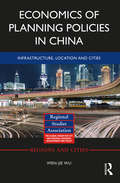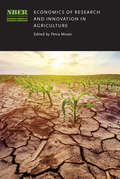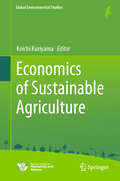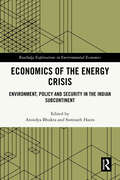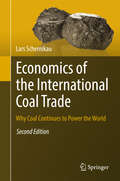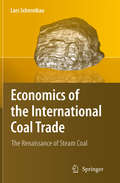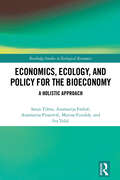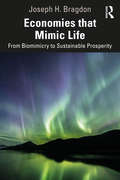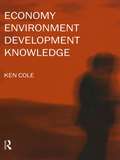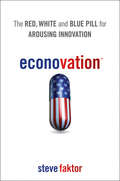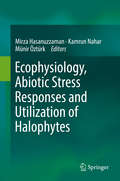- Table View
- List View
Economics of Nuclear Power
by Geoffrey RothwellThis book is a unique introduction to the economic costs of nuclear power. It examines the future of the nuclear power industry and unpacks the complicated relationships between its technical, economic and political variables. It does so by modelling the costs, risks and uncertainties of one of the world’s most opaque industries using micro-econometrics, econometrics, and cost engineering. Economics of Nuclear Power examines the very important costs of externalities (storing of nuclear waste and the impact of a Chernobyl or Fukushima event) and compares those to the externalities of alternative carbon based energies (oil, coal, natural gas). With over 100 tables and figures this book details nuclear power production around the world - present and planned, providing a completely global focus. It also includes an overview of the past 70 years of international nuclear power developments. This book is essential reading for students, scholars and professionals interested in energy economics, nuclear engineering and energy policy.
Economics of Planning Policies in China: Infrastructure, Location and Cities (Regions and Cities)
by Wen-jie WuFast urbanizing countries like China have experienced rapid – albeit geographically uneven – local and regional economic growth during the past few decades. Notwithstanding this development pattern, China has been investing heavily in targeted coastal and inland regions through planning policies for infrastructure, location and cities. This is a largely place-based investment process that is of great importance for the public, business and policymakers. China’s urban and regional transformations provide incentives for spatial agglomeration and will shift the growth of activities within and across cities for decades to come. This spatial differentiation is likely to be driven by government decisions at all levels about where, when and in what to invest, in an institutional context where policy instruments act to constrain or facilitate China’s urban and regional development. Economics of Planning Policies in China looks at the role that the institutional characteristics of the Chinese planning system and market mechanisms play in transforming and shaping the infrastructure, location and cities with the potential for spatial disparity and inclusive growth. The planning and geographical perspective and evidence make this book a reference for international scholars, policymakers and graduates
Economics of Renewable Energy: An Assessment of Innovations with Statistical Data
by Yoram KrozerThe book provides a comprehensive review of renewable energy from an economic perspective throughout the last two hundred years, starting from traditional renewable energy based on bio and hydro energy. The focus is on modern renewable energy based on geothermal, wind, and solar energy. It emerged when innovative entrepreneurs captured opportunities for valuable energy services. As the services with renewable energy expanded, the costs of technologies decreased entailing global commercialisation. This enables larger access to energy and emission reduction of carbon dioxide, but also causes larger differences in the energy resources across countries which impedes international policies. That optimistic viewpoint on the shift to the global low-carbon economy is largely based on statistical data about purchasing power, energy consumption and businesses, and valuable energy services in many countries on all continents. The data are presented in 70 tables, graphs, and figures, most of them original. Interpretation of the data are useful in support of decisions making about sustainable development in civil society, businesses, and policy makers as well as for the verifications of scholarly hypotheses and projections in energy and climate policies.
Economics of Research and Innovation in Agriculture (National Bureau of Economic Research Conference Report)
by Petra MoserFeeding the world’s growing population is a critical policy challenge for the twenty-first century. With constraints on water, arable land, and other natural resources, agricultural innovation is a promising path to meeting the nutrient needs for future generations. At the same time, potential increases in the variability of the world’s climate may intensify the need for developing new crops that can tolerate extreme weather. Despite the key role for scientific breakthroughs, there is an active discussion on the returns to public and private spending in agricultural R&D, and many of the world’s wealthier countries have scaled back the share of GDP that they devote to agricultural R&D. Dwindling public support leaves universities, which historically have been a major source of agricultural innovation, increasingly dependent on industry funding, with uncertain effects on the nature and direction of agricultural research. All of these factors create an urgent need for systematic empirical evidence on the forces that drive research and innovation in agriculture. This book aims to provide such evidence through economic analyses of the sources of agricultural innovation, the challenges of measuring agricultural productivity, the role of universities and their interactions with industry, and emerging mechanisms that can fund agricultural R&D.
Economics of Research and Innovation in Agriculture (National Bureau of Economic Research Conference Report)
by Petra MoserFeeding the world’s growing population is a critical policy challenge for the twenty-first century. With constraints on water, arable land, and other natural resources, agricultural innovation is a promising path to meeting the nutrient needs for future generations. At the same time, potential increases in the variability of the world’s climate may intensify the need for developing new crops that can tolerate extreme weather. Despite the key role for scientific breakthroughs, there is an active discussion on the returns to public and private spending in agricultural R&D, and many of the world’s wealthier countries have scaled back the share of GDP that they devote to agricultural R&D. Dwindling public support leaves universities, which historically have been a major source of agricultural innovation, increasingly dependent on industry funding, with uncertain effects on the nature and direction of agricultural research. All of these factors create an urgent need for systematic empirical evidence on the forces that drive research and innovation in agriculture. This book aims to provide such evidence through economic analyses of the sources of agricultural innovation, the challenges of measuring agricultural productivity, the role of universities and their interactions with industry, and emerging mechanisms that can fund agricultural R&D.
Economics of Rural Land-Use Change (Ashgate Studies in Environmental and Natural Resource Economics)
by Kevin J. BoylePublic concern over land management has never been greater. This book provides a broad overview of the economics of rural land-use change, drawing attention to the meaningful role economic analysis can play in resolving public concern and supporting future, pro-active land management strategies in rural areas. The book's breadth distinguishes it from other recent texts, as it jointly offers rigorous treatments of theoretical and empirical models of rural land-use change and practical discussions of applications and relevant methods. Chapters are specifically designed to demonstrate the types of land-use questions economic analysis can answer, the types of methods that might be employed to answer these questions, and the types of public policy decisions that may be supported by such analysis. The book makes a significant contribution to contemporary land-use research, highlighting the key methodological and public policy issues that will be central to future research on the economics of rural land-use change.
Economics of Sustainable Agriculture (Global Environmental Studies)
by Koichi KuriyamaFertilizers are indispensable for agricultural production. Chemical fertilizers have significantly improved agricultural productivity. However, the excessive use of fertilizers has caused serious nitrogen pollution. What is the reason of a lack of progress in addressing nitrogen pollution? What is necessary to achieve sustainable nitrogen use in agriculture? This book provides a new perspective from an economic standpoint on these questions. Firstly, we propose the non-market valuation methods to evaluate the social costs of nitrogen. Because nitrogen control requires considerable effort and cost, evaluating the costs and benefits of nitrogen measures in monetary terms allows for a comparison of the expenses and benefits of nitrogen control, despite the delays in implementing such measures in the agricultural sector. Secondly, we analyze the behavioral changes of producers and consumers regarding nitrogen to indicate the direction of agricultural environmental policies for sustainable nitrogen use in the future. To achieve sustainable nitrogen use, farmers and consumers need to adopt production and consumption behaviors that consider nitrogen. By analyzing the effects of "visualizing" the nitrogen footprint on the behavioral changes of farmers and consumers, this book not only highlights the limitations of conventional agricultural policies but also provides recommendations for future agricultural environmental policies.
Economics of the Energy Crisis: Environment, Policy and Security in the Indian Subcontinent (Routledge Explorations in Environmental Economics)
by Somnath Hazra Anindya BhuktaThe global energy crisis is a two-dimensional phenomenon: on the one hand, the gap between a continuously depleting supply capacity of fossil fuel and rapidly increasing demand for energy is fast widening, and, on the other, the burning of fossil fuels intensifies the problem of global warming day by day.This book explores this global crisis through a regional focus, exploring the issues as they relate to the Indian subcontinent. The book argues that since no source of energy is entirely pollution-free, it is essential to place greater emphasis on enhancing energy-use efficiency. This requires proper auditing of existing energy use and proper management of future use. Providing the foundation for this argument, the first section of the book examines the root cause of the problem: the supply-demand imbalance of energy. Alongside this, market imperfections in energy pricing are also discussed. The second section of the volume explores the environmental and political dimensions, examining policies in the region designed to provide a sustainable environment. The third and final sections present several plausible policy prescriptions to solve the problem.This book will be of particular interest to researchers of energy economics and policy, sustainability, environmental studies and South Asia more broadly.
Economics of the International Coal Trade
by Lars SchernikauCoal, the catalyst of the industrial age, is now poised to shape how the world consumes energy in the twenty-?rst century. The ascendance of oil in the global economy to a looming peak is forcing countries, companies, and consumers to reconsider their relationship to something they cannot live without: energy. And whileothersourcesofenergy, suchasnuclear, naturalgas, andrenewables, willall play an ever greater role in serving demand, intelligent observers would be wise not to miss what is perhaps the clearest trend of all: the second coal era is now uponus. Thedevelopingworldisrapidlyelectrifyinginordertodriveeconomicgrowth. Andelectri?cationmeanscoal. ThisisparticularlytrueinIndiaandChina, where coaloffersthecheapestandmostreliableroutetoelectricpower. Thesetwoco- triesalonewilldrive80%ofcoalconsumptiongrowthto2030. TheInternational EnergyAgencyexpectsthatglobalcoalconsumptionwillincreaseby60%inthe nexttwodecades. LarsSchernikau sTheRenaissanceofSteamCoalcouldnotcome atabettertime. Lars skillintracingthelongarcofindustrialevolutionpairedwith his acute knowledge of the coal market make his arguments both insightful and highlycredible. Hebeginsbysuccinctlyframingtheproblemanddistillingourc- rentpredicament: wearecaughtbetween theOilAge andthe theSolarAge (by thishemeanstheageofrenewables). Wearealloptimiststosomedegree, butthe realistsamongusknowthatrenewableenergyisnotgoingtocompletely?llthis gapfordecades. Where, then, doesthisleaveus?ItleavesuswithTheRenaissance ofSteamCoal. Coal is now the world s fastest growing source of fossil fuel, a position it is expected to hold for the foreseeable future. Yet the coal market is far less well understoodthantheoilorgasmarkets. Academics, policymakers, andmarketp- ticipantsarefacedwiththeprospectofourcollectiveknowledgeaboutthismarket notkeepingpacewithitsincreasingrelevance. Coal, only30yearsagoalocalized fuelsource, isnowavolatileglobalcommoditywithbanksandhedgefundspiling intotheoncetraditionalbusiness. Notonlyisthecoalmarketnowmorerelevant thanever, it salsomuchmorecomplex. "
Economics of the International Coal Trade: The Renaissance of Steam Coal
by Lars SchernikauThe world today depends on oil, coal and gas (in that order of importance) for over 80% of its primary energy. From the time humans tamed fire, wood or bio-mass became the primary energy source. Coal took over from biomass during the Industrial Revolution and accounted for over 60% of world primary energy by the early 1900s. The current age is often referred to as the Oil Age, which seems appropriate now that about 35% of the world's primary energy still comes from oil. However, coal is experiencing a renaissance. Today about one quarter of the world's primary energy and more than 40% of the world's electricity comes from coal. In addition, about two thirds of the world's steel is produced using coal. The author predicts that coal will become even more important in the decades to come, mainly driven by demand from China and India. This book focuses on the role of coal for today's energy and, most importantly, electricity markets. It starts with a review of coal as a resource, profiling the major steam coal exporting nations and the structure of the supply market. The low investment rate in coal compared to other fossil fuels is discussed, and environmental and safety issues with coal production are reviewed. The book examines how coal is used in the modern world. It compares coal to other energy resources and speculates on a greater role for coal in the medium-term future. It examines the structure of the steam coal market, contract terms, derivative markets, FOB costs, and introduces the WorldCoal market model. The final chapter summarizes conclusions and predictions. The author predicts more and larger merger attempts in the coal supply arena and further efforts to manage this development through public policy, greater investment by market participants in logistics and upstream assets, and the development of exchange-based coal trading through standardized coal volumes. The author also outlines why he believes coal prices will rise, eventually catching up with gas.
Economics of the Oceans: Rights, Rents and Resources
by Paul HallwoodIt is an unfortunate truth that our oceans offer valuable resources that are too often used unsustainably. Time and again this is due to the failure of international law to provide a framework for adequate governance. Economics of the Oceans examines this issue and provides a comprehensive study of ocean uses from the perspectives of law and economics. Themes covered in the book include ocean governance, the economics of oceanic resource exploitation, offshore oil, coral reefs, shipwrecks and maritime piracy. Analytical techniques such as basic game theory, environmental economics of the commons and cost-benefit analysis are employed to illuminate the topics. This book will be of interest to students of environmental economics, natural resource economics and management, and the economics of international law as relating to the oceans.
Economics of the SDGs: Putting the Sustainable Development Goals into Practice
by Edward B. Barbier Joanne C. BurgessThis is the first book that employs economics to develop and apply an analytical framework for assessing progress towards the Sustainable Development Goals (SDGs). The authors explore the historical context for the underlying sustainability concept, develop an economics-based analytical framework for assessing progress towards the SDGs, and discuss the implications for sustainability policy and future research. Economics is concerned with analysing the trade-offs in allocating scarce means to achieve various ends. Thus, economic methods are ideally suited to assessing how progress towards one or more SDGs may come at the expense of achieving other goals. Such interactions are inevitable in meeting the 2030 Agenda over the next decade, given that the SDGs include different economic, social, and environmental elements. Although it may be possible to make progress across all 17 goals by 2030, it is more likely that improvement toward all goals will be mixed. For example, we may have reduced poverty or hunger over recent years, but the way in which this progress has been achieved – e.g. through economic expansion and industrial growth – may have come at the cost in achieving some environmental or social goals. On the other hand, progress in reducing poverty is likely to go hand-in-hand with other important goals, such as eliminating hunger, improving clean water and sanitation, and ensuring good health and well-being. Assessing these interactions is essential for guiding policy, so that countries and the international community can begin implementing the right set of environmental, social and economic policies to achieve more sustainable and inclusive global development.
Economics, Ecology, and Policy for the Bioeconomy: A Holistic Approach (Routledge Studies in Ecological Economics)
by Sanja Tišma Anamarija Farkaš Anamarija Pisarović Marina Funduk Iva TolićThis book demonstrates that a holistic approach to the bioeconomy is essential if it is to achieve its full potential in driving economic growth while simultaneously providing ecological, social and technological benefits. Definitions of the ‘bioeconomy’ vary but in general it incorporates the ways in which societies manage and distribute their primary or secondary biological resources for further use in everyday life (e.g. food, materials, and energy). The classical sectors related to the bioeconomy have therefore been agriculture, forestry and aquaculture, now extended to include bioenergy, biofuels, biochemicals, and other processing and service industries. There are also related new concepts such us the blue economy, the green economy, and the circular economy. This book integrates these definitions, sectoral analyses and new concepts into a fully rounded study of the bioeconomy. It is argued that the key aims in the coming years have to be the harmonization of public policies between different sectors, regulation of legislative framework for the bioeconomy, and clear communication of these issues. In particular, the book argues that a strengthening of the monitoring and evaluation of the impacts of the bioeconomy on society is an essential starting point. For this to be effective, appropriate indicators need to be established and defined for the monitoring of the effects of these resilient policies related to bioeconomy and their impact on local and regional development and quality of life. This book will be essential reading for anyone interested in the bioeconomy including students and scholars of ecological economics, environmental economics, sustainability, innovation, and regional development.
Economics, Management and Sustainability: Essays In Honour Of Anup Sinha (India Studies in Business and Economics)
by Partha Ray Runa Sarkar Anindya SenThis book presents an eclectic mix of interesting new areas in the domain of economics, management and sustainability. Written by leading experts, it provides valuable food for thought, with essays introducing new lines of research and empirical research papers offering sound research methodology. The book not only provides answers, but also raises numerous interesting questions concerning the areas covered to whet readers’ appetites to learn more. Professor Anup Sinha is a respected teacher and is a great mind with wide-ranging academic interests spanning from economics and sustainability to management. As well as in various other places in India and the US, he has taught at the Indian Institute of Management Calcutta and Presidency College (now a University) Calcutta for almost three decades. To commemorate his contributions, this festschrift presents a collection of essays that are broadly subdivided into four sections: Economic Development; Vulnerabilities and Inclusive Growth; Sustainability and Corporate Governance; and Innovation and Management.
Economics, Sustainability, and Democracy: Economics in the Era of Climate Change (Routledge Frontiers of Political Economy #159)
by Christopher NobbsHow should we conduct economics in an era of climate change, natural resource depletion and population increase? These issues are systemic, and involve great uncertainties and long time horizons. This book contends that the free-market economics that has dominated capitalist democracies in recent decades is not up to the task; that the welfarist economics that preceded it, while preferable, also has inadequacies; and that what is required is an economics founded on ecological principles, greater respect for the laws of natural science, and a moral commitment to a sustainable future. The book commences with an exposition of major aspects of orthodox macroeconomic and microeconomic theory. It then explores the bounds of orthodox theory in relation to ethics, liberalism, ideology, society, the international economy, globalization, and the environment, and seeks lessons for a future economics. Issues raised by natural resource use and climate change are given particular prominence. Many of the issues of critical importance in coming decades involve not private goods but public goods: goods which markets are ill-equipped to deal with. In the resolution of these issues political processes will need to be engaged. The availability to each individual of clean air, clean water and adequate sustenance, goods which cannot be provided for by economic production alone, are of central concern. While acknowledging the importance of market processes, the author argues in favour of a more deliberative and democratic economy, the greater engagement of civil society, environmental human rights and responsibilities, and in favour of a World Environment Organization, change in the conduct of the World Trade Organization, and for economists to accept moral responsibility for the policies they advocate. Specific case studies are given and potential policies outlined. This book will be of interest not only to economists but also to citizens generally and students concerned with public affairs.
Economies that Mimic Life: From Biomimicry to Sustainable Prosperity
by Joseph H. BragdonThe world economy today is at an historical inflection point. The neoclassical (industrial) model of economics is self-destructing while a new life-mimicking model, based on radically different assumptions, is emerging. Although rarely acknowledged in economic journals, Nordic countries, which pioneered the life-mimicking model, have become world leaders in prosperity and productivity while those operating on the older neoclassical/industrial model are trapped in downward spirals. By approaching economies as sub-systems of life rather than super-systems that transcend life, we gain transformative insights. Such thinking led to the first circular economy experiments in Kalundborg (Denmark) during the 1970s, then quickly spread to the rest of the Nordic world. By placing a higher value on living assets (people and Nature) than on non-living capital assets, this approach generates harmony rather than exploitation and conflict. Because Nordic people feel vested in the system and responsible for its success, they are extraordinarily innovative and productive. That is why Nordic companies are regularly rated among the world’s most sustainable and profitable in their fields – even though their region holds less than half of one percent of the world’s population. Written in an accessible way for non-economists, the book is ideal for readers interested in the benefits of biomimicry and methods of guiding democratic countries along a proven path of self-renewal. Economies That Mimic Life will also provide useful background for corporate leaders in scenario planning and strategic thinking. Knowing which way the political-economic wind is blowing will become increasingly important to corporate survival.
Economies, Institutions and Territories: Dissecting Nexuses in a Changing World (The Dynamics of Economic Space)
by Neil Reid Luca Storti Giulia UrsoPresenting multidisciplinary and global insights, this book explores the nexus between economies, institutions, and territories and how global phenomena have local consequences. It examines how original and innovative economic related processes embed themselves in societies at the local level; how boundaries between the state and the market are placed under stress by unexpected changes. It explores whether new types of elites and forms of social inequalities are emerging as a result of institutional and economic changes, and whether peripheral areas are experiencing insidious forms of economic and institutional lock-in. Presenting empirical cases and useful analytical and conceptual tools, the book makes current economic and territorial phenomena more understandable. This is an important read for students and scholars in the fields of geography, sociology, political sciences, anthropology, economics, regional science, and international relations. It is also a valuable resource for policymakers, well-educated lay readers and economic, political and international relations journalists.
Economy-Environment-Development-Knowledge
by Ken ColeAs we approach the end of the second millennium, we find ourselves in times of radical social change. Orthodox explanations of the economy, the environment and the development process are unable to provide coherent policies for such issues as employment creation, environmental degradation and social progress.Economy-Environment-Development-Knowledge provides alternative perspectives on these fundamental aspects of human existence. Economists, environmentalists, and development theorists have so far been unable to agree on the most successful prescriptions to address problems. To understand, contrast and compare alternative understandings of economic, environmental and development issues, we need to be aware why theorists conceptualise the process of social experience so differently.Part 1 of Economy-Environment-Development-Knowledge addresses the subjective preference, cost-of-production and abstract labour theories of values in economics; Part 2 explains egocentrism, ecocentrism and socioecocentrism as competing theoretical perspectives in environmental theory; Part 3 highlights modernisation theory, structuralist theory and class struggle as ways to account for the process of development and Part 4 examines the generation of knowedge through positivism, paradigms and praxis, legitimating competing perspectives in economics, environmentalist and development. The book concludes by considering why different people find alternative explanations more or less plausible.By addressing the disagreements between theorists, Economy-Environment-Development-Knowledge provides a unique basis to contrast and compare the plethora of theories of, and policies for, economic prosperity, environmental sustainability and social progress.
Economy: Critical Essays in Human Geography (Contemporary Foundations Of Space And Place Ser.)
by Ron MartinEconomic geographers have always argued that space is key to understanding the economy, that the processes of economic growth and development do not occur uniformly across geographic space, but rather differ in degree and form as between different nations, regions, cities and localities, with major implications for the geographies of wealth and welfare. This was true in the industrial phase of global capitalism, and is no less true in the contemporary era of post-industrial, knowledge-driven global capitalism. Indeed, the marked changes occurring in the structure and operation of the economy, in the sources of wealth creation, in the organisation of the firm, in the nature of work, in the boundaries between market and state, and in the regulation of the socio-economy, have stimulated an unprecedented wave of theoretical, conceptual and empirical enquiry by economic geographers. Even economists, who traditionally have viewed the economy in non-spatial terms, as existing on the head of the proverbial pin, are increasingly recognising the importance of space, place and location to understanding economic growth, technological innovation, competitiveness and globalisation. This collection of previously published work, though containing but a fraction of the huge explosion in research and publication that has occurred over the past two decades, seeks to convey a sense of this exciting phase in the intellectual development of the discipline and its importance in grasping the spatialities of contemporary economic life.
Econophysics and Companies: Statistical Life and Death in Complex Business Networks
by Hideaki Aoyama Yoshi Fujiwara Yuichi Ikeda Hiroshi Iyetomi Wataru SoumaEconophysics is an emerging interdisciplinary field that takes advantage of the concepts and methods of statistical physics to analyse economic phenomena. This book expands the explanatory scope of econophysics to the real economy by using methods from statistical physics to analyse the success and failure of companies. Using large data sets of companies and income-earners in Japan and Europe, a distinguished team of researchers show how these methods allow us to analyse companies, from huge corporations to small firms, as heterogeneous agents interacting at multiple layers of complex networks. They then show how successful this approach is in explaining a wide range of recent findings relating to the dynamics of companies. With mathematics kept to a minimum, the book is not only a lively introduction to the field of econophysics but also provides fresh insights into company behaviour.
Econophysics of Income and Wealth Distributions
by Bikas K. Chakrabarti Anirban Chakraborti Satya R. Chakravarty Arnab ChatterjeeThe distribution of wealth and income is never uniform, and philosophers and economists have tried for years to understand the reasons and formulate remedies for such inequalities. This book introduces the elegant and intriguing kinetic exchange models that physicists have developed to tackle these issues. This is the first monograph in econophysics focussed on the analyses and modelling of these distributions, and is ideal for physicists and economists. It is written in simple, lucid language, with plenty of illustrations and in-depth analyses, making it suitable for researchers new to this field as well as specialized readers. It explores the origin of economic inequality and examines the scientific steps that can be taken to reduce this inequality in the future.
Econovation: The Red, White, and Blue Pill for Arousing Innovation
by Steve FaktorOver the last 20 years, China fed our zombie-like appetite for iPhones, Prada and Snuggies. At the same time, its biggest customer, the US, found itself in debt, under-educated, and covered with recreational tattoos. So now what? Will America wallow in mediocrity like Greece or some C-list celebrity? Or, will our legendary ingenuity save us from Tweeting...and eating our way to irrelevance? Econovation is a bold, witty response to those questions that doesn't rely on miracles or government for answers. It challenges business leaders to think differently about the next decade of the US economy and respond with big, sustainable innovations. Written by Steve Faktor, former Vice President of Growth & Innovation and head of the Chairman's Innovation Fund at American Express, Econovation is a trends book on steroids. It's bursting with practical, thought-provoking ideas no executive, entrepreneur or Fed Chairman can afford to miss. Most importantly, Econovation envisions a very different future. It's one ruled by "producerism", not consumerism. It's a future in which real innovators must do more than slide a greasy finger over the screen of an iPad. Econovation uncovers opportunities in unexpected places. You'll learn how to: Capitalize on a market that will go from making nothing to making everything...for China. Use psychological pricing and some crafty tricks from Google to reduce reliance on tapped-out consumers Sell to consumers whose new identities will be based on what they create, not what they buy, click or super-size Seduce a desperate government to finance your business, then feed you pancakes in the morning Motivate tomorrow's employee with social currency instead of the green, depreciating kind Upgrade your business and your kids with a little help from Mormons and kindergartners with hacksaws Econovation is a fresh perspective on a future we've taken for granted. It empowers readers to think big, dream big, and conquer economic conditions that will paralyze others. With a hefty dose of data, humor, and actionable ideas, Econovation offers insight and amusement in one, convenient place - a rare treat for a business book.
Ecopedagogies: Practical Approaches to Experiential Learning
by Ellen Bayer Judson Byrd FinleyEcopedagogies showcases a range of creative approaches that educators across multiple disciplines use to empower students to access and engage with nature, an increasingly important consideration in a post-COVID world in environmental crisis. The volume includes chapters written by scholars from the environmental arts and humanities, literature, writing studies, rhetoric, music, religious studies, environmental studies and sustainability, sociology and anthropology, physical education, and outdoor education. Each author walks the reader through the details of how their ecopedagogy works, identifies potential challenges while also detailing how to address them, and explains the rewards to students, instructors, and more-than-human nature that they have witnessed through the use of these approaches. The contributions represent diverse types of academic institutions, offering broad applicability to instructors, including community colleges, private liberal arts colleges, and large state, regional, public, and private universities. The book explores a series of key questions about how educators can facilitate meaningful learning experiences with the natural world, inside and outside the classroom, and it looks at how to foster inclusivity, navigate problems with access, and explore intersections with environmental justice. As a practical guide, the book delivers a well-provisioned toolbox containing exercises, activity guides, and assignments for those teaching environmentally focused college courses.
Ecopharmacovigilance
by Leobardo Manuel Gómez-OlivánThe indiscriminate use of medications and their inadequate disposal have resulted in them being released into the environment via municipal, hospital and industrial discharges. This volume critically examines the presence of pharmaceuticals in aquatic ecosystems, the hazards they entail, and how to minimize their impact on the environment. The topics covered include: historical findings that have made the development of the discipline ecopharmacovigilance possible; the main exposure routes, fate and life cycle of pharmaceuticals in water; occurrence data and the impact on biodiversity; methods used for the detection, analysis and quantification of pharmaceuticals in water and for their removal; current legislation on the presence of emerging contaminants in water; biosensors for environmental analysis and monitoring; and the measures needed to reduce the existing problems. This book is aimed at students, academics and research workers in the fields of toxicology, ecology, microbiology and chemistry, as well as those in the pharmaceutical industry, health sector professionals, and members of government bodies involved in environmental protection and legislation.
Ecophysiology, Abiotic Stress Responses and Utilization of Halophytes
by Münir Öztürk Mirza Hasanuzzaman Kamrun NaharHalophytes are those plant species that can tolerate high salt concentrations. There are diversified species of halophytes suited for growth in various saline regions around the world, e.g. coastal saline soil, soils of mangrove forests, wetlands, marshlands, lands of arid and semiarid regions, and agricultural fields. These plants can be grown in soil and water containing high salt concentrations and unsuitable for conventional crops, and can be good sources of food, fuel, fodder, fiber, essential oils, and medicine. Moreover, halophytes can be exploited as significant and major plant species for the desalination and restoration of saline soils, as well as phytoremediation. This book highlights recent advances in exploring the unique features of halophytes and their potential uses in our changing environment.

